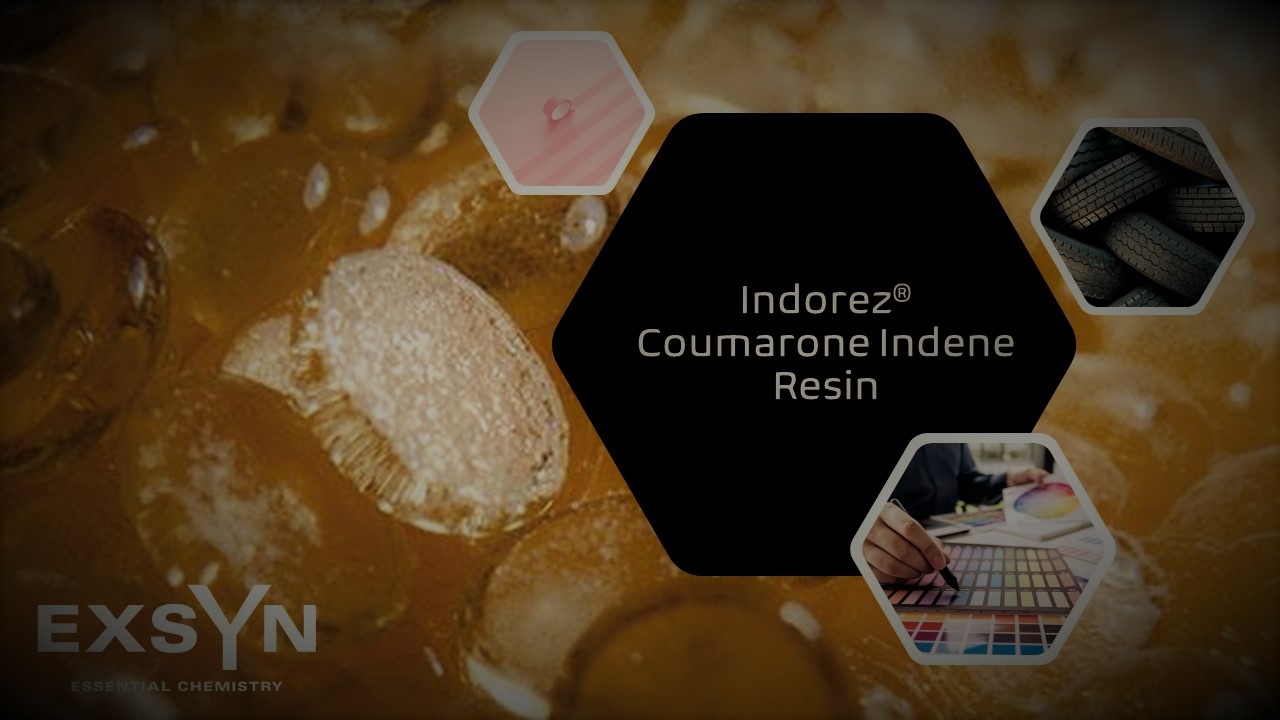INTRODUCTION
Indorez® Coumarone Indene Resin also known as CI Resin, is a thermoplastic aromatic resin which is produced through the polymerization of coumarone, indene & styrene. Each of these three ingredients play an important role in the performance of CI resin. Coumarone imparts cohesiveness and works as process aid, Styrene imparts heat resistance and Indene imparts transparency and better adhesiveness.
Coumarone Indene Resin has very good affinity with natural and synthetic rubbers. Its key characteristics include imparting good performance as a tackifier, softening and reinforcing agent.
These type of resins are designed to have excellent resistance to alkalis, dilute acids and moisture. They can improve the moulding operation, increase the hardness and elasticity of the product.
| Synonym | Coumarone Resin |
| CAS no. | 63393-89-5 |
| Molecular Formula | C8H6O |
SPECIFICATIONS [OC-100 – Typically used grade in rubber industry]
| Test | Unit | Specification |
|---|---|---|
| Appearance | – | Brownish Transparent Granules |
| Colour | Ga# | Max 18 |
| Softening Point (Ring & Ball) | °C | 90 – 100 |
| Acid Value | mgKOH/g | Max 0.30 |
| Ash | % | Max 0.05 |
APPLICATIONS
Excellent tack retention, higher adhesive bond strength, etc. are some important characteristics of Coumarone Indene resins which makes it a resin of choice in rubber, coatings and adhesive applications. CI resin is used as a tackifier and softener for natural and synthetic rubber.
| Applications |
|---|
| Rubber Compounds, Tyres, Tubes, Belts & other Rubber products |
| Adhesives and Adhesive tapes |
| Varnishes, Anti-Corrosive Paints & Coatings |
| Printing Inks |
PACKAGING
25 Kg Bags
STORAGE
Store in a sheltered place away from sources of heat and moisture.
No matter the quantity you need, our exceptional quality and service will make ExSyn your supplier of choice! If you need any additional information or SDS, please get in touch with us.
Phosphatidylcholine (PC) is one of the most important phospholipids derived from soya lecithin and represents a key structural component of cell membranes. Phosphatidylcholine 90% refers to a highly purified grade where the PC content is enriched to around 90% through specialized extraction and purification steps.
Indorez® Kota Resin is a modified non self-cured phenolic resin, it can increase rubber adhesion to steel, polyester, rayon, nylon, aramid and other fabric cord. It’s an adhesive agent, acts as methylene acceptor, can 100% replace resorcinol and resorcinol resins in resorcinol- formaldehyde-silica, enhance adhesion between rubber and reinforcing materials.
Glyceryl Stearate Citrate (GSC) is a plant-derived, biodegradable emulsifier commonly used in cosmetics and personal-care products. It functions primarily as an anionic oil-in-water (O/W) emulsifier, helping blend oils and water into smooth, stable creams and lotions. Its natural origin and gentle profile make it popular in eco-certified, organic, and sensitive-skin formulations.
DL-Serine is a racemic mixture of both the D- and L-forms of the amino acid serine, which is a polar, nonessential amino acid. It is an α-amino acid characterized by its hydroxyl-containing side chain, which enables it to take part in numerous biochemical reactions and synthetic processes. It functions as a pivotal intermediate in the biosynthesis of amino acids, including glycine and cysteine, underscoring its essential role in cellular metabolism. Moreover, it constitutes a critical pharmaceutical intermediate for the synthesis of a broad spectrum of therapeutic agents and drug candidates.
Ethyl vinyl ether is a reactive, flammable, volatile liquid with a strong ether-like odor. Featuring two conjugated functional groups—an ether and an alkene—this molecule act as important building block, especially in polymer synthesis. Its applications span multiple industrial sectors, including semiconductors, coatings, inks, fragrances, adhesives, paints, oil viscosity modifiers and pharmaceuticals, with promising potential as a dietary supplement.
Peppermint (Mentha piperita) is a common herb, also known as a hybrid mint. Its main components are oxygenated monoterpenes: alcohols, esters and ketones. Peppermint oleoresin microencapsulated powder is a white to off-white coloured powder produced from the seeds of the plant. In order to protect and maintain the stability of peppermint oil, microencapsulation is carried out through process optimization using the coacervation technique. This technique helps limit the loss and degradation of flavours and aromas during processing and storage. It offers versatile applications across multiple industries — from food and beverages to pharmaceuticals, cosmetics, and textiles.
5-Methyl-3-vinyl-2-oxazolidinone (V-MOX) is a highly reactive monomer valued for its low viscosity, mild odor, and excellent reactivity. It is widely used as a reactive diluent in UV-curable inks and coatings, where it enhances adhesion, produces brighter colors, and improves safety compared to conventional diluents. In addition, V-MOX serves as a key building block in the synthesis of kinetic hydrate inhibitor (KHI) polymers, which are applied in oil and gas production to prevent hydrate blockages in pipelines.
Zinc ricinoleate is the zinc salt of ricinoleic acid, a hydroxylated fatty acid derived mainly from castor oil (Ricinus communis). It appears as a white to slightly yellowish powder, waxy solid, or paste, depending on formulation. Its most valuable property is its ability to trap and absorb odor molecules such as amines, sulfides, and short-chain fatty acids, making it an essential ingredient in deodorant and odor-control products.
2-(tert-Butyl amino)ethyl methacrylate (TBAEMA) is a functional methacrylate monomer that contains a secondary amine group and a hydrophobic tert-butyl moiety, giving it excellent versatility in pH-responsive and adhesion-enhancing polymer systems.
It is valued in printing ink formulations for its ability to enhance adhesion, flexibility, and surface interaction.
